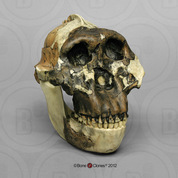-
Fields of Study
- K-12 Education
- Advanced Anatomy
- Forensics
- Physical Therapy
- Primate Locomotion
- Non-primate Locomotion
- Biological Anthropology
- Paleontology
- Bioarchaeology
- Marine-Aquarium
- Veterinary
-
Zoology
- All Zoological Items
- Endangered Species
- Skulls
- Skeletons
- Cranial Elements
- Postcranial Elements
- Eggs
- Limbs
- Teeth & Fangs
- Claws & Talons
- Brains & Endocasts
- Life Casts
- Pathology & Trauma
- Wildlife Forensics
- Sets
- Bird Sets
- Accessories
- Birds
- Mammals
- Reptiles & Amphibians
- Fish
- Sharks & Rays
- Turtles & Tortoises
- Anatomy for the Artist
- Decor
- Veterinary
- Elements
- Pathology & Trauma
-
Sets & Series
- Natural History Gift Ideas
- Decor
- Scale & Sculpture
- 3D Scanned & Printed
- Bone Boxes
- Locomotion Sets
- Forensic Sets
- Advanced Anatomy Sets
- Physical Therapy Series
- Fetal Sets
- Economy Series
- Zoology Sets
- Bird Sets
- Claw & Talon Sets
- Tooth & Fang Sets
- Primate Skull Sets
- Fossil Hominid Sets
- B.I.O.P.S.I. - Babiarz Institute
- Maxwell Collection
- Bergdorf Goodman Windows
- Accessories
- New Products
-
Our Company
- News & Specials
- Printable Handouts
- About Us
- Why Choose Bone Clones
- Bone Clones in the News
- Mission
- Contact Us
- Privacy and Security
- FAQs
- Testimonials
- Community Outreach
- Legal/Copyright
- Flyers
- Choosing Original Specimens
- Museum Exhibitions
- Natural History Gift Ideas
- About the Economy Series
- Acknowledgements
- Ordering & Delivery
- Warranty
- Refund/Return Policy
- Price List at a Glance
- Our Catalog
- Osteological Evaluation Reports
- About 3D Printing
- Sawyer & Maley Neanderthal Reconstruction
- Site Introduction
- Newsletter Archive
-
Human Anatomy
- All Human Anatomy
- Human Skulls
- Human Skeletons
- Head & Neck
- Postcranial Elements
- Advanced Anatomy
- Physical Therapy / Joints
- Human Brains & Endocast
- Human Life Casts
- Maxwell Museum
- Sets & Series
- Accessories
- Osteological Evaluation Reports
- Featured
- Adult Human Anatomy
- Adolescent Human Anatomy
- Child Human Anatomy
- Fetal Human Anatomy
-
Zoology
- All Zoological Items
- Endangered Species
- Skulls
- Skeletons
- Cranial Elements
- Postcranial Elements
- Eggs
- Limbs
- Teeth & Fangs
- Claws & Talons
- Brains & Endocasts
- Life Casts
- Pathology & Trauma
- Wildlife Forensics
- Sets
- Bird Sets
- Accessories
- Birds
- Mammals
- Reptiles & Amphibians
- Fish
- Sharks & Rays
- Turtles & Tortoises
- Fossil Hominids
- Paleontology
- Non-human Primates
- Forensics
All items sold on this website are replicas; no real/natural bone is available on this site. Bone Clones® are 1:1 scale unless stated otherwise. All Bone Clones® products are made in the USA.
 ALSO SEE:
ALSO SEE:
A robustus SK-54 Cranium Section with Punctures
BHK-001 $189.00
Australopithecus (Paranthropus) robustus SK-54 Juvenile cranium section, dated at 1.5 million years, was discovered in 1949 Swartkrans, South Africa by Robert Broom and J.T. Robinson. This juvenile calotte (skull cap) possesses two 6mm puncture wounds close to the intersection of the sagittal and lambdoidal sutures (Brain 1981).
First thought to lend evidence to Robert Dart's "killer Ape theory" (the theory of war and interpersonal aggression being the driving force behind human evolution), the depressed fractures were thought to be the result of an attack by pointed weapon. Years later, after subsequent excavations headed by C.K. Brain, a new, now generally accepted, theory was introduced: the punctures were produced by a leopard attack.
C.K. Brain used another Swartkrans' find, a lower mandible from an African leopard, to hypothesize that the young victim's wounds were from a predator/prey scenario rather than warring primates. To demonstrate this, he matched the lower canines of an African leopard with the puncture wounds of the robustus. Both the canines and the puncture wounds were at equal distanced of 33mm (Brain 1981).
Reports of an analysis of an endocast that was later conducted in 2004 by Ralph Holloway and others states, "This endocast also clearly shows the two 'leopard' puncture holes made by the lower canines, supposedly as this hominid was dragged to the beast's feeding place, presumably a tree" (Holloway et.al 2004).
For comparison purposes our consultants were able to recreate the lower canines aligning with the fractures by using our Snow Leopard Skull, Male BC-056. While not an African leopard, this is a powerful demonstration for students.
Brain, C.K. The Hunters or the Hunted? An Introduction of African Cave Taphonomy. Chicago: The University of Chicago Press. 1981.
Holloway, R.L., Broadfield, D.C., Yuan, M.S. The Human Fossil Record: Brain Endocasts - The Paleoneurological Evidence, Vol. 3. John Wiley & Sons, Inc. 2004
| Scientific Name | Catalogue # | Size | Price |
| Australopithecus robustus | BHK-001 | 4" wide | $189.00 |
Related Products:
-
 Australopithecus robustus Cranium SK-48 with Reconstructed Jaw
Australopithecus robustus Cranium SK-48 with Reconstructed Jaw -
 Australopithecus robustus Cranium SK-48
Australopithecus robustus Cranium SK-48 -
 Australopithecus boisei Cranium OH 5 (Zinjanthropus)
Australopithecus boisei Cranium OH 5 (Zinjanthropus) -
 Australopithecus boisei Skull OH 5 (Zinjanthropus)
Australopithecus boisei Skull OH 5 (Zinjanthropus) -
 Australopithecus africanus Skull (Taung Child)
Australopithecus africanus Skull (Taung Child) -
 Australopithecus afarensis Skull "Lucy" (dark finish)
Australopithecus afarensis Skull "Lucy" (dark finish) -
 Australopithecus afarensis Skull "Lucy" (light finish)
Australopithecus afarensis Skull "Lucy" (light finish) -
 Set of 7 Primate Skulls with Lesson Plan
Set of 7 Primate Skulls with Lesson Plan -
 Set of 4 Hominid Skulls, Half Scale
Set of 4 Hominid Skulls, Half Scale -
 Australopithecus afarensis Skull "Selam"
Australopithecus afarensis Skull "Selam"
Newsletter Signup
9200 Eton Ave.
Chatsworth, CA 91311 USA
© 1992-2025 Bone Clones Holdings. All Rights Reserved.
Customer Service
© 2025 BONE CLONES HOLDINGS / Made by MEV














